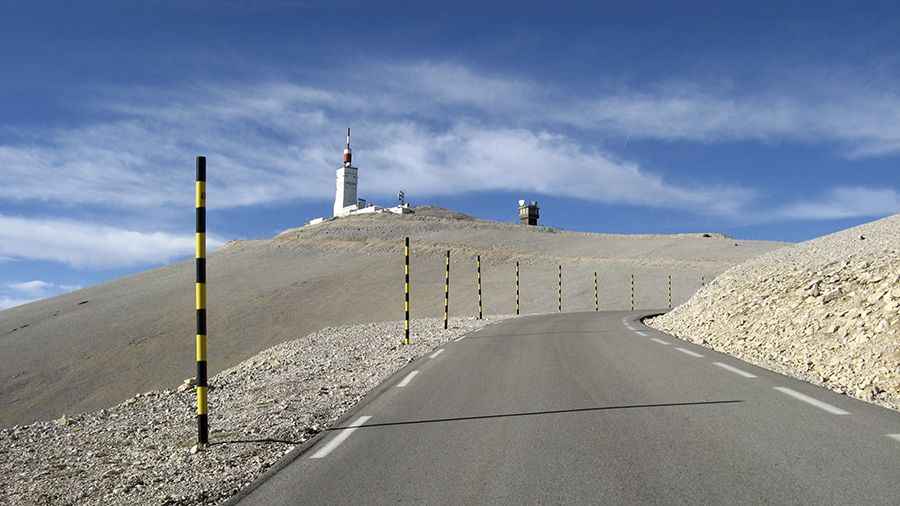Why is the epic road to Mont Ventoux so famous?
Mont Ventoux is a high mountain peak at an elevation of 1.912m (6,273ft) above the sea level, located in France.

Where is Mont Ventoux?
The peak is located in the Vaucluse department, in the Provence-Alpes-Côte d'Azur region, in the southeastern part of the country.
Can you drive up Mont Ventoux?
Tucked away in the Mont Ventoux Natural Regional Park, the road to the summit is 2-cars wide and well paved, running through a white lunar landscape. It’s called D974. After the Chalet Reynard ski station, the road is a bit steeper, winding up the open, treeless slopes; the more sensitive parts of this last 6 km are protected with guardrails.
How long is Mont Ventoux?
The road to the summit is 21.4 km (13.29 miles) long, starting at Bédoin, in the Vaucluse department. The road leading to the peak opened in 1900.
What does Ventoux mean?
This infamous mountain stripped by the winds has been nicknamed the "Giant of Provence", or "The Bald Mountain". The area is known for its strong winds. It can be extremely windy at the summit, especially with the mistral; wind speeds as high as 320 km/h (200 mph) have been recorded. The wind blows at 90+ km/h (56+ mph) 240 days a year. It’s on all the “top rides” lists. Some say the name Ventoux comes from "venteux", the French for "windy", and reflects the mountain's exposure to the fierce north-west Mistral wind. The top of the mountain is bare limestone without vegetation or trees, which makes the mountain's barren peak appear from a distance to be snow-capped all year round (its snow cover actually lasts from December to April).
Is Mont Ventoux open?
Set high in the Savoy Alps region of the French Alps, the road to the summit is open between mid-April and mid-November, though it can be shut throughout the year if the weather is bad. In summers snow can be present at the summit. The summit is exposed to extreme climatic conditions. The last kilometres may have strong and violent winds. The road is often closed due to high winds, especially at Col de Tempêtes ("storm pass") just before the summit.
Why is Mont Ventoux so difficult?
The climb is very hard due to windy conditions and/or heat and you’ll be very exposed to the elements at higher altitude on this mountain. It’s one of the hardest and most epic climbs you can ride on two wheels. If you decide to attempt this ascent, make sure you check the weather at the summit and take appropriate clothing with you. It’s considered the most fearsome of France's climbs, with the asphalt rising consistently at around 10 percent most of the way, and exposed to often very strong winds.
Who died on Mont Ventoux?
The climb is epic due its brutality and has become legendary as the scene of one of the most grueling climbs in the Tour de France race, which has ascended the mountain many times. The peak gained its reputation for claiming the life of English cyclist Tom Simpson who collapsed of exhaustion and died during the 1967 Tour, aged 29. Official cause of death was heat exhaustion.
How long does it take to drive to Mont Ventoux?
To drive the road without stopping will take most people between 30 and 45 minutes. It’s usually crowded with thousands of bicycles, and near the peak, because of this, there are traffic jams and all possibilities to park your vehicle near the peak are blocked. The drive offers stunning views. Its isolated position overlooking the valley of the Rhône ensures that it dominates the entire region and can be seen from many miles away on a clear day. The view from the top is correspondingly superb. On clear days, it is even possible to glimpse the Mediterranean Sea to the south and the snow-capped Mont Blanc to the north.
How hard is the climb of Ventoux?
The climb is really brutal, hitting a 12.9% of maximum gradient through some of the ramps. It has gained fame through its use in the Tour de France cycling race. Starting at Bédoin, the ascent is 21.4 km long. Over this distance, the elevation gain is 1.639 meters. The average percentage is 7.6 %. If you’re only riding Mont Ventoux once, make it Bédoin to Ventoux. It’s the route the Tour has taken several times, the one Tom Simpson died on, the iconic climb that everyone will assume you’re doing if you tell them you’re cycling Mont Ventoux.
Image credit: Depositphotos